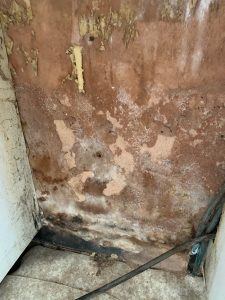A Damp Issue – Rising Damp, Definitely Not Funny
This is the third and final blog in our short series on “damp” that hopefully provides answers to some of our most FAQs. In the first blog we considered “Condensation Dampness”, and then followed it up by looking at “Penetrating Dampness”. This time we are considering “Rising Damp”, what it is and how to deal with it.
Whenever “Rising Damp” is mentioned, I always think about the 1970s sitcom of the same name and if you have an issue with rising damp in your home, it’s about as not funny as the dated humour of that TV programme!
The ‘good’ news is that true rising damp is actually very rare (and often misdiagnosed as such) but working out what to do about it can be a very controversial issue for mortgage lenders, surveyors, damp specialists and building conservation professionals.
What is Rising Damp?
Rising Damp is moisture from the ground that rises up the wall by capillary action through porous brick or stone. It can usually only rise to around 75-90cm from the ground. As the moisture rises, it brings with it salts from the plaster which leave a sort of tide mark on the wall. As with any internal dampness, rising damp also causes the wall to be clammy to the touch and leaves behind a musty smell. Left untreated it can cause wet and dry rot to any timbers it is in contact with, such as floor joists and skirting boards.
Age Matters
To prevent dampness from the ground, houses built post the Building Acts of 1875 were required to be constructed with a physical damp proof course (DPC). However, our experience shows that this was often not the case for houses built in South Wales during the house building boom of the late 19th century. Where they are present, DPC’s were first provided by layers of slate or lead, engineering bricks or later, bituminised felt. Modern homes are constructed with a plastic DPC.
Over time DPCs can become defective or moisture can bridge the barrier in some way causing problems. Older buildings built without DPCs usually have damp from the ground to some degree. However, as long as the building is allowed to ‘breathe’ in the way it was originally constructed to do this is not a problem. Problems in older buildings occur when the moisture equilibrium is disturbed in some way, usually by the use of inappropriate renders or the misguided use of injected chemical DPCs into construction materials unsuitable for this treatment.
The usual way that home surveyors (including us!) measure dampness is to take readings using an electrical moisture meter. High readings indicate moisture in the wall and highlight a potential problem. However, these readings whilst useful, should always be viewed in the context of the age and construction of the building and used merely as a tool to work out what is going on with the building as a whole. Otherwise, this can lead to unnecessary and possibly damaging damp-proofing work.
Possible Remedies
As with all building problems, the Golden Rule is ‘Don’t Ignore It’. However, if rising dampness is suspected, careful diagnosis is needed as there are several similar issues which can masquerade as true rising damp, including penetrating dampness and pesky condensation dampness (see our other blogs!). Bear in mind that an injected DPC should always be the last resort. There are some common sense actions which you should consider first. For example:
- Check outside ground levels. Make sure that earth or flower beds are not banked up against the outside walls. Consider installing a gravel-filled ‘French Drain’ around the walls so water can drain away from the property and moisture can evaporate.
- Patios, paving slabs, wooden decking etc should be kept away from the main walls and at least 15 cm below the level of the DPC. This will prevent bridging of the DPC and /or rainwater splashing up the wall from the hard surfaces.
- Any render or other wall covering should also stop above the level of the DPC and have a ‘bellmouth drip’ detail or shape to the bottom, which prevents rainwater from dripping onto the brick wall beneath. Render or cement plinths should be removed if they cover and ‘bridge’ the DPC.
- Check that dampness is not caused by penetrating water. Make repairs to leaky gutters, blocked drains, cracks around windows and doors, slipped roof tiles and chimney flashings.
- Consider the possibility of condensation dampness and correct the balance of insulation, heating and ventilation in the home.
- Hack off affected internal plaster and allow the wall to dry fully before re-plastering. This may take many months, particularly during winter but is key to solving the problem. Consider re-plastering with a salt resistant waterproof plaster. Older houses may benefit from a lime-based plaster which allows moisture to evaporate.
Any dampness in the home is stressful. However, remember that true rising damp is rare and that there are many potential causes and remedies to consider before resorting to expensive damp-proofing works. As we have discussed, most damp to lower walls is caused either by penetrating dampness or from external ground levels that are too high. If in doubt, ask the advice of an experienced surveyor!
To find out more about how we can help you, contact us on 01685 378894 or 02920 6225433.




